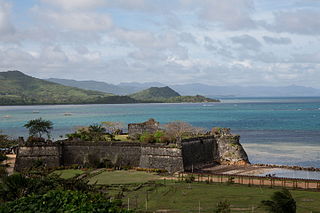
The provinces of the Philippines are the primary political and administrative divisions of the Philippines. There are 81 provinces at present, further subdivided into component cities and municipalities. The local government units in the National Capital Region, as well as independent cities, are independent of any provincial government. Each province is governed by an elected legislature called the Sangguniang Panlalawigan and by an elected governor.

A fortification is a military construction or building designed for the defense of territories in warfare, and is also used to solidify rule in a region during peacetime. The term is derived from the Latin fortis ("strong") and facere.

Dipolog, officially the City of Dipolog, is a 3rd class city and capital of the province of Zamboanga del Norte, Philippines. According to the 2015 census, it has a population of 130,759 people.

Cagayancillo, officially the Municipality of Cagayancillo,, is a 6th class municipality in the province of Palawan, Philippines. According to the 2015 census, it has a population of 6,285 people.

Bongabong, officially the Municipality of Bongabong,, is a 1st class municipality in the province of Oriental Mindoro, Philippines. According to the 2015 census, it has a population of 72,073 people.

Tourism is an important sector for Philippine economy. In 2015, the travel and tourism industry contributed 10.6% to the country's GDP. Philippines is an archipelagic country composed of 7,641 islands with 82 provinces divided in 17 regions. The country is known for having its rich biodiversity as its main tourist attraction. Its beaches, heritage towns and monuments, mountains, rainforests, islands and diving spots are among the country's most popular tourist destinations. The country's rich historical and cultural heritage, including its festivals and indigenous traditions, are also one of the attractions of Philippines. Popular destinations among tourists are Cebu, Boracay, Palawan, Siargao, and many more.

Montenegro Shipping Lines, Inc. (MSLI) is a domestic shipping line with headquarters at the port of Batangas City in the Philippines. It operates passenger, cargo and roll-on/roll-off for vehicular traffic traveling between islands of the Philippines.

The architecture of the Philippines reflects the historical and cultural traditions in the country. Most prominent historic structures in the archipelago are influenced by Austronesian, Chinese, Spanish, and American architectures.

The National Museum of the Philippines is an umbrella government organization that oversees a number of national museums in the Philippines including ethnographic, anthropological, archaeological and visual arts collections. Since 1998, the National Museum has been the regulatory and enforcement agency of the Government of the Philippines in the restoring and safeguarding of important cultural properties, sites, and reservations throughout the Philippines.

Fort Santa Isabel also known as Taytay Fort is a coastal fortification in the town of Taytay of Palawan, Philippines.

The Fort of Saint Vincent Ferrer or commonly known as Punta Cruz Watchtower (Bantayan ng Punta Cruz) is a Spanish colonial era watchtower located at the western tip of the municipality of Maribojoc, Bohol, Philippines. Also known as Maribojoc Watchtower because of its geographical location, it is located three kilometers (1.9 mi) away from Maribojoc Church. It is known for being the "only perfect isosceles triangle" tower-fort structure in the Philippines.

The San Ignacio de Loyola Parish Church, commonly known as Capul Church or Fuerza de Capul, is a Roman Catholic fortress church in the municipality of Capul, Northern Samar, Philippines within the jurisdiction of the Diocese of Catarman. It was first established as a mission station by the Jesuits in 1596 under the advocacy of Saint Ignatius of Loyola.
Philippines National Historic Landmarks is a registry of historic sites in the Philippines that have been officially declared by the Philippine Registry of Cultural Property.

























